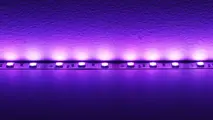What is LED color temperature?

Color temperature represents the most common indicator of the spectral quality of a light source. Color temperature is defined by an absolute black body. When the radiation of the light source is exactly the same as the radiation of the absolute black body in the visible region, the temperature of the black body is called the color temperature of the light source. The characteristic of low color temperature light sources is that there is relatively more red radiation in the energy distribution, which is usually called "warm light"; when the color temperature is increased, the proportion of blue radiation in the energy distribution increases, which is usually called "cold light".
The unit is absolute temperature K (Kelvin, or Kelvin temperature) (K=℃+273.15). Therefore, when the black body is heated to red, the temperature is about 527°C or 800K, and other temperatures affect the change of light color. During the day, the light color of sunlight also changes with time: about 40 minutes after sunrise, the light color is more yellow, with a color temperature of 3,000K; at noon, the sunlight is white, rising to 4,800-5,800K, and at noon on a cloudy day, it is about 6,500K; at sunset, The front light color is reddish, and the color temperature drops to 2,200K. Because the correlated color temperature is actually based on the black body radiation approaching the light color of the light source, the evaluation value of the light color performance of the light source is not an accurate color comparison. Therefore, even two light sources with the same color temperature value may still have slight differences in the appearance of light color. It is impossible to understand the color rendering ability of the light source to the object or the reproduction of the color of the object under the light source based on the color temperature alone.
The color temperatures of some commonly used light sources are: standard candlepower is 1930K (Kelvin temperature unit); tungsten lamp is 2760-2900K; fluorescent lamp is 3000K; flash lamp is 3800K; noon sunlight is 5400K; electronic flash lamp is 6000K; blue sky is 12000-18000K.
Preferences in color temperature vary from person to person, and are related to the scenery we see every day. For example, for people close to the equator, the average color temperature they see every day is 11000K (8000K (dusk) ~ 17000K (noon)). Therefore, people prefer high color temperatures (which look more realistic). On the contrary, people in areas with higher latitudes (average color temperature is about 6000K) prefer low color temperatures (5600K or 6500K).
The color temperature of the light source is different, and the color of the light is also different. A color temperature below 3300K has a stable atmosphere and a warm feeling; a color temperature between 3000--5000K is an intermediate color temperature and has a refreshing feeling; a color temperature above 5000K has a cold feeling. Different light colors from different light sources can create different lighting environments

The relative relationship between color temperature and brightness: When illuminated by a high color temperature light source, if the brightness is not high, it will give people a gloomy atmosphere; when illuminated by a low color temperature light source, if the brightness is too high, it will give people a stuffy feeling.
Contrast of light color: When two light sources with large differences in light color are used in the same space, the contrast will produce a gradation effect. When the light color contrast is large, not only the brightness level can be obtained, but the light color level can also be obtained.
Color temperature 3500K is a color temperature close to incandescent light, often called warm white, which makes people feel relaxed and comfortable. It is suitable for residences, hotels, restaurants and other lighting places that need to create a warm environment; color temperature 4500K is white and soft light, similar to Compared with the light of ordinary energy-saving lamps, it is suitable for homes, offices, schools and hospitals, etc.; white light with a color temperature of 6500K has better light penetration. At the same power, it feels brighter and cooler than products with a color temperature of 3500K or 4500K. , often called cool white, is suitable for large-area lighting in shopping malls, corridors, halls, stations, industrial plants and other places. If you live in the north where winters are relatively cold, we recommend using warm white light (4500K) or incandescent light (3500K) products. However, if it is used for reading and studying, it is best to choose products with positive white light (6500K). Not only does the brightness feel high, but it is also suitable for reading environments that are mainly black and white. Of course, from the perspective of home lighting, we must also consider the color of the furniture in the home, the style of decoration and the owner's personal preferences. Generally speaking, incandescent light gives people a retro warm-toned visual experience, while positive white light products conform to modern and simple decorative styles.





